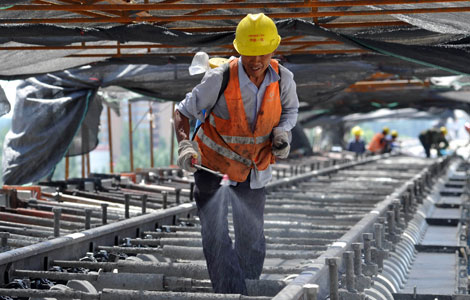Cooperating for posterity
Updated: 2013-07-15 03:21
By Zhang Zixuan (China Daily)
|
|||||||||||
The Palace Museum in Beijing has a host of historical exhibits that take a lifetime to preserve and maintain. To keep these relics safe for posterity, the museum has stepped up efforts with a new partner.
Many imperial treasures gathering dust in the Forbidden City will soon see the light of day again, restored to their former glory under a new rescue and repair project — a cooperation between the Palace Museum and the Beijing Dongcheng district government, a deal sealed by a strategic agreement in January this year.
The new initiative is part of "The Safe Palace Museum" project.
 |
|
A furniture craftsman with the Palace Museum works on a red sandalwood chair. Below: Many ancient Chinese paintings collected in the Palace Museum need elaborate restoration by repair masters. Zhang Fan / Xinhua |
"The Palace Museum is our lifeline so protecting it is our responsibility," says Dongcheng district director Niu Qingshan.
The cultural relics waiting to be repaired all belong to the Palace Museum collection, which fall into seven major categories: wooden furniture, royal lamps and lanterns, carts and palanquins, music instruments, walking sabers and swords, opera costumes, and Chinese silk tapestry.
Expert craftsmen, all heritage inheritors from traditional workshops such as the Beijing Opera Costume Factory and the Beijing Enamel Factory located in Dongcheng district, will be invited to restore the objects in the Palace Museum.
It will be the first time it is done on such a large scale.
"Dongcheng district is home to numerous crafts inheritors, many of whose teachers had worked in the Qing Dynasty (1644-1911) Court's manufacture office," says Palace Museum director Shan Jixiang. "They are very familiar with the objects they're going to repair."
The Palace Museum has a large collection of objects from the seven categories, Shan says.
The numbers are staggering, with 9,640 pieces of opera costumes, 1,448 lamps and lanterns, and some 300 carts and palanquins. Many have succumbed to the ravages of time and wear and tear. The repair project was supposed to take place several months later in the museum's 476,000-square-meter new branch at the north complex currently under construction, but museum director says it cannot wait.
Several rooms within the Hall of Consolation of Mothers (Ci Ning Gong) are now being used as temporary studios, and the work will move into the north complex at the end of this year when it is completed. Visitors will then be able to view the progress of the repairs.
"We cannot afford any delay since many of the masters are advanced in years," says Sun Ying, a state-level inheritor of opera costume making.
Today's Top News
27 killed, 77 wounded in attacks across Iraq
French train derailment kills six: media
Former S.A President confident of Mandela
US seeking direct nuke talks with Iran
Soulik batters Taiwan, Fujian coast
Death toll rises to 43 in SW China landslide
Russia: no Snowden asylum plea yet
3rd Chinese girl dies in Asiana crash
Hot Topics
Lunar probe , China growth forecasts, Emission rules get tougher, China seen through 'colored lens', International board,
Editor's Picks

|

|

|

|

|

|





